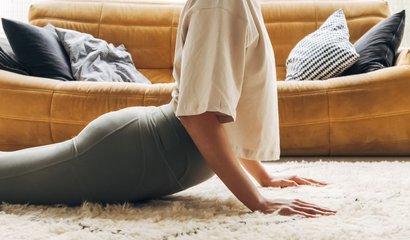May 1, 2025
How Often Should You Do Yoga? Why 3 Times a Week Works Best
If you're trying to build a sustainable at home yoga practice, you're not alone. Most people don’t struggle with motivation—they struggle with consistency. Maybe you’ve rolled out your mat once, got stuck in a 45-minute flow, and then ghosted it for the rest of the month. We’ve all been there.
The good news? You don’t need to commit to seven days a week, two-hour sessions, or turn your living room into a zen sanctuary. You just need three yoga at home classes a week. That’s it.
Whether you're brand new to yoga at home or easing back after a break, a 3x/week rhythm offers structure without pressure. It's flexible, sustainable, and—most importantly—doable.

How Often Should You Practice Yoga to See Results?
Let’s get to the question everyone asks: "How many times a week should I do yoga to see results?"
Research into beginner-level hatha yoga shows that even one 90-minute session per week over ten weeks can lead to measurable improvements in balance, flexibility, and core strength—especially in healthy young adults. But let's be real: most people don't have a spare 90 minutes lying around each week, let alone the mental space to plan and commit to it consistently.
Add to that the general health guidelines that recommend 150 minutes of moderate-intensity aerobic activity per week (or 75 minutes of vigorous activity), and it’s easy to see why people feel stuck.
What we’ve observed in our online yoga studio is this: people make the most progress when they stop trying to cram their yoga into an already busy life and instead build it in with intention.
That’s why we recommend starting with just three classes a week—short or long, restorative or strong. When members focus on the habit first (instead of performance), they’re more likely to:
- Enjoy their practice
- Feel proud of showing up
- Stick with it long enough to see real change
As their confidence grows, they naturally begin to explore longer classes, new teachers, and more frequent practice. But it all begins with a rhythm that feels spacious, not stressful. This is how you build a home practice that lasts—and actually fits your life. It's enough to see changes in flexibility, strength, and stress levels—without burning out or blowing up your calendar.
If you’re wondering, "Is 30 minutes of yoga 3 times a week enough?"—absolutely. You could even do less. A consistent yoga home practice—even in 15-minute bites—will move the needle more than random hour-long efforts once a month.
Why You Don’t Need Daily Yoga (and Might Not Want It)
Is yoga seven days a week too much? For most people—yes. Unless you're living in a retreat bubble or riding high on a new routine, long daily yoga classes are hard to sustain (and honestly, not necessary).
Practicing yoga at home three times a week gives your body time to recover, your mind space to integrate, and your schedule room to breathe. You're not chasing perfection—you're building a rhythm that fits your actual life.
We’ve also noticed something beautiful inside our Heart + Bones community: many members come to yoga because they love doing other things. Think mountain bikers with tight hips, runners who need mobility, desk-bound weekend warriors, gardeners with sore backs, or those managing aging bodies or chronic pain.
By approaching your yoga home practice with balance, you leave space for everything else you love. Three classes a week becomes more than a yoga routine—it becomes the foundation that supports the rest of your life.

Why 3 Yoga Classes a Week Is the Magic Number
Here’s what happens when you show up three times a week:
- You stop negotiating with yourself and just hit play
- Your body remembers the movements quicker
- You start to feel better—not just on the mat, but in your day-to-day
- You build confidence and capability without burnout
You’ll create a routine you can stick to—because it meets you where you’re at.
And over time, the benefits add up:
- By Week 1–2: You might notice fewer aches, better sleep, or that “hey, my hips feel looser” moment
- By Week 3–4: You’ll start building strength, improving mobility, and feeling more grounded in your body
- Long-term: You’ll experience improved posture, reduced pain, and a stronger connection between mind and movement—without needing a 90-minute class every day
Consistency is where the transformation happens. Practicing yoga at home three times a week isn’t just “good enough”—it’s one of the most realistic and rewarding ways to build lasting results.
Want to Make It Easy?
Join Heart + Bones Yoga and commit to just **three classes a week** through our online yoga studio. You'll get access to 350+ sustainable, anatomy-informed classes for every body, every schedule, and every stage of life. Start with a **7-day free trial** to explore what feels good. And because we believe that three classes a week is all it takes to fall in love with movement—we’ll give you **30 days of unlimited access for just $1** after that. No pressure. Just progress.
What Counts as a Yoga Class at Home?
A yoga at home class doesn’t have to be a big event. It could be:
- A 10-minute nervous system reset
- A 20-minute fascia-focused mobility session
- A slow, sleepy restorative class before bed
If you're showing up and breathing with awareness? You're doing it right.
Platforms like Heart + Bones Yoga make it easy to find the right yoga at home classes—whether you’ve got 5 minutes or 50. You’ll find options for all energy levels, body needs, and time windows.
One of the biggest mindset shifts we encourage in our online yoga community is this: something is always better than nothing. Even when you’ve been consistent for a while, life can throw off your routine. That’s normal. The key is to keep a flexible mindset—if the class isn’t long or “perfect,” it still counts.
When you stop waiting for the ideal conditions and just take the next doable step, your yoga home practice becomes something you can return to again and again.

How to Build an At Home Yoga Routine That Sticks
- Start Short – Lower the barrier. 10–15 minutes is enough to begin.
- Schedule It – Choose your 3 days and protect them like your favourite Netflix show.
- Set the Scene – A yoga mat, a corner of the floor, and maybe your dog watching you—perfect.
- Track the Habit – Whether it’s a journal, sticker chart, or app, celebrate the days you show up.
- Let It Be Imperfect – Loud neighbours, laundry in the corner, or low energy? Still counts.
Can You Do Yoga Every Day?
Yes—you can practice yoga every day. But do you need to? Not at all.
A daily yoga practice can feel great, especially if you’re alternating between movement, breath, and rest. But more important than doing yoga every day is learning how to listen to your body—and choosing the right kind of practice for what it needs that day.
At Heart + Bones, we focus on sustainable yoga. That means building a practice that supports your body long-term—not just today. For many of our members, that looks like three intentional, well-supported classes a week. Enough to feel strong, mobile, and calm—without burning out or tuning out.
Listening Is the Real Practice
We’ve designed our online studio to support a variety of needs and energy levels. Whether your wrists are feeling tender or you’re dealing with cranky knees, there are wrist-free, knee-free, and gentle options ready for you. Need to learn how to modify plank or make downward dog actually feel good? That’s what our Move + Learn classes are for.
Your body is always giving you feedback. The goal isn’t to push through—it’s to learn how to respond with care.
Some signs it might be time to shift gears:
- You feel unusually fatigued or sore after practice
- A pose consistently creates discomfort or tension
- You're dreading your practice instead of looking forward to it
That’s when you pause. Switch to a restorative or fascia class. Try a shorter session. Or simply take a break. Rest isn’t failure—it’s a vital part of building a lasting yoga habit.
Our Take on Injury Prevention
While yoga, like any movement, has the potential for strain, we design our classes to help you move smarter, not harder. Through anatomy-informed guidance, functional movement, and a focus on individual needs, our approach helps you build resilience—not wear and tear.
In other words: we don’t just hope you’ll avoid injury. We teach you how to move in ways that prevent it.


